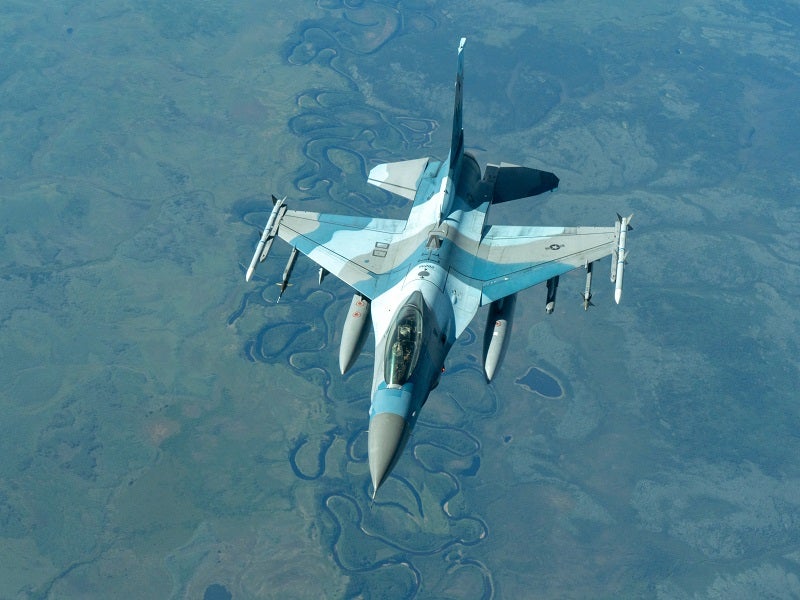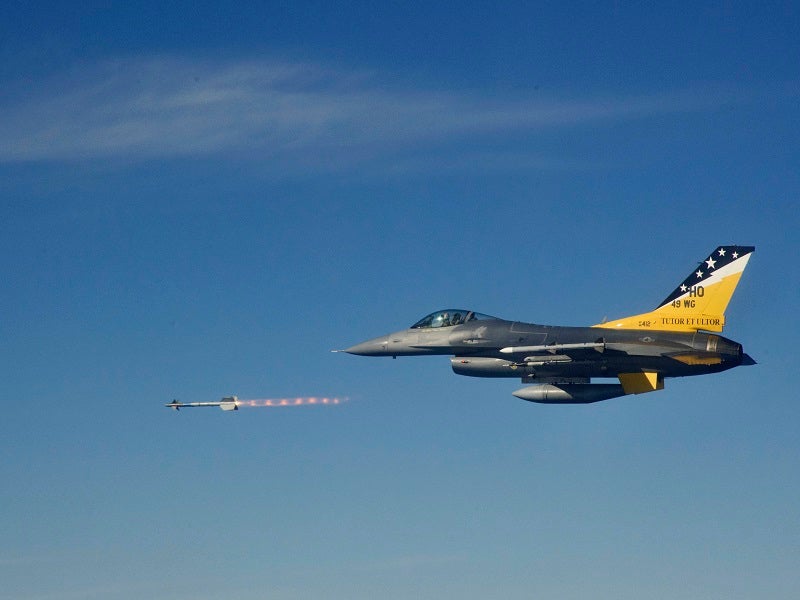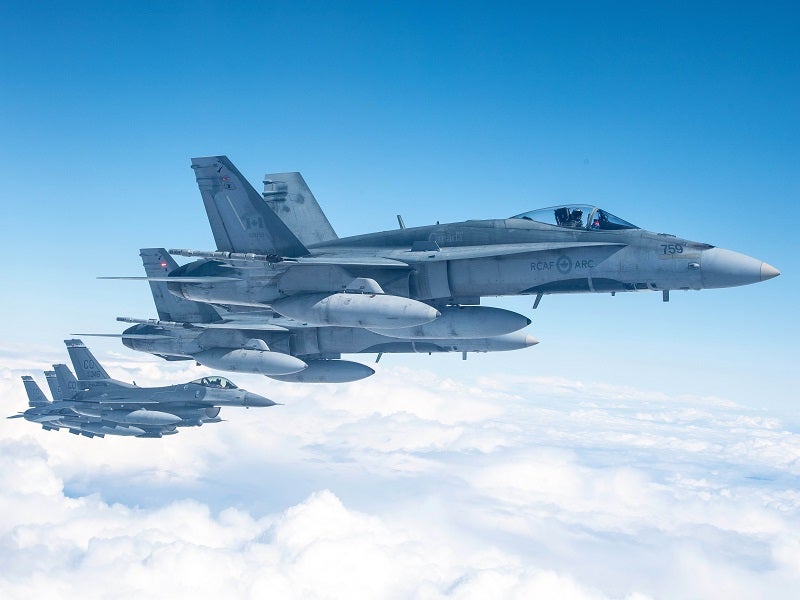The Lockheed Martin F-16 Fighting Falcon is one of the world’s most prolific fighter aircraft. Lockheed Martin delivered about 4,600 F-16s to over 25 countries. More than 3,000 F-16 fighters are currently operational worldwide. The F-16 and the F-15 Eagle were the world’s first aircraft able to withstand higher gravitational-equivalent forces than the pilots. The Fighting Falcon entered service in 1979. The last of 2,231 F-16 fighters for the US Air Force (USAF) was delivered in March 2005. The first two-seat F-16D version was accepted by the US government in January 2009.
Lockheed Martin delivered the F-16 fighter to a number of countries including Bahrain, Greece, Iraq, Israel, Egypt, Morocco, New Zealand, United Arab Emirates, Singapore, South Korea, Oman, Chile, and Poland.
Aerospace Industrial Development Corporation (AIDC) and Lockheed Martin signed an agreement to establish an F-16 fighter jet maintenance centre in Taiwan, in December 2019.
The fighter aircraft completed more than 13 million sorties and approximately 19.5 million flight hours, as of August 2021. The F-16 Block 70/72, the latest production configuration, has been ordered by five countries so far.
F-16 Fighting Falcon cockpit
Advanced equipment fitted on the current build of the F-16 includes Honeywell colour flat-panel liquid crystal multifunction displays, digital terrain system, modular mission computer, colour video camera to record the pilot’s view of the head-up display (HUD), a colour triple-deck video recorder and an enhanced programmable display generator.
Under the USAF project Sure Strike, the F-16 is equipped with an improved data modem (IDM), which automatically provides target data to the HUD using data transmitted by a ground observer.
The seat-back angle of the aircraft has been increased from 13° to 30° to provide increased comfort for the pilot.
A follow-on programme, project Gold Strike, integrated an upgraded IDM for the transmission of images to and from a range of sources, including ground units and unmanned aircraft. The system can transmit images from the LANTIRN targeting pod and display video imagery to the cockpit.
The USAF F-16 aircraft features the Boeing joint helmet-mounted cueing system (JHMCS), currently in full-rate production. Deliveries of production systems began in 2004 and the system was first deployed operationally during Operation Iraqi Freedom.
The USAF partnered with Collins Elbit Vision Systems (CEVS), a joint venture between Collins Aerospace and Elbit Systems of America, on the JHMCS II helmet display. Equipped with new technologies such as visor-projected symbology, an optical/inertial tracker, and up-look reticles, the JHMCS II completed safety qualification testing.
The new system was flight tested aboard the F-16V aircraft as a part of USAF’s Military Flight Release (MFR) for the F-16V Block-70/72 in August 2020.
F-16 missiles and weapons
The aircraft has nine hardpoints for weapons payloads: one at each wing tip, three under each wing, and one centreline under the fuselage. The ordnance is launched from Raytheon LAU-88 launchers, MAU-12 and Orgen bomb ejector racks. The port wing is fitted with a 20mm General Electric M61A1 multi-barrel cannon and the gunsight is interfaced to the cockpit HUD.
Air-to-air missiles carried on the F-16 include the Lockheed Martin / Raytheon AIM-9 Sidewinder, Raytheon AMRAAM, Raytheon Sparrow, MBDA (formerly Matra BAe Dynamics) Skyflash and ASRAAM, and the MBDA R550 Magic 2. In April 2004, the F-16 first fired the new-generation AIM-9X Sidewinder, which is in full-rate production for the USAF.
Air-to-surface missiles carried on the F-16 include Maverick, HARM and Shrike missiles, manufactured by Raytheon, and anti-ship missiles include Boeing Harpoon and Kongsberg Penguin. Flight tests with the Lockheed Martin joint air-to-surface stand-off missile (JASSM) have been conducted from the F-16.
The first guided launch of the new joint direct attack munition (JDAM) was successfully carried out from an F-16. The F-16 was the first USAF aircraft to be fitted with the joint stand-off weapon (JSOW) in April 2000.
The F-16 can be fitted with Lockheed Martin wind-corrected munitions dispenser (WCMD), which provides precision guidance for CBU-87, -89, and 97 cluster munitions. The system corrects for launch transients, ballistic errors, and winds aloft.
The F-16 was the first aircraft to use the USAF’s new weapon rack, the Edo Corporation BRU-57. The BRU-57 is a vertical ejection rack which doubles the aircraft’s capacity for precision-guided weapons such as the JDAM and WCMD.
All-weather stand-off weapons, such as the AGM-84E stand-off land-attack missile (SLAM) and the AGM-142 Popeye II, are planned to be included in future upgrades to the aircraft. Other advanced weapons include MICA, IRIS-T, Python IV, Active Skyflash air-to-air missile, ALARM antiradiation missile, Apache multi-mission stand-off weapon, autonomous free-flight dispenser system and AS30L laser-guided missile.
Targeting The F-16 carries the Lockheed Martin LANTIRN infrared navigation and targeting system. This is used in conjunction with a BAE Systems holographic display. Block 50/52 aircraft are equipped with the HARM targeting system, AN/ASQ-213 from Raytheon.
US Air National Guard F-16 aircraft are fitted with Northrop Grumman Litening II / Litening ER targeting pods.
In August 2001, Lockheed Martin was selected to provide the Sniper XR as the new advanced targeting pod for USAF F-16 and F-15E aircraft.
Sniper XR (extended range) incorporates a high-resolution mid-wave FLIR, dual-mode laser, CCD TV, laser spot tracker and laser marker combined with advanced image processing algorithms. Deliveries began in March 2003.
The F-16 fighters for Oman are equipped with BAE Systems advanced airborne reconnaissance system, while those for Poland and Morocco are equipped with the Goodrich DB-110 reconnaissance pod.
F-16 Fighting Falcon countermeasures
The Block 50 F-16 aircraft for the US are equipped with the Lockheed Martin superheterodyne AN/ALR-56M radar warning receiver. The F-16 is also compatible with a range of jammers and electronic countermeasures equipment, including Northrop Grumman AN/ALQ-131, Raytheon AN/ALQ-184, Elisra SPS 3000 and Elta EL/L-8240, and the Northrop Grumman ALQ-165 self-protection suite.
Lockheed Martin ALE-40 and ALE-47 chaff and infrared flare dispenser systems are installed in an internal flush mount. ALE-40 is pilot-controlled but the ALE-47 installed in block 50 can be operated in fully-automatic, semi-automatic or manual mode.
F-16s for the Greek Air Force are being fitted with the Raytheon advanced self-protection integrated suite (ASPIS) II, which includes Northrop Grumman ALR-93(V) threat warning system, Raytheon ALQ-187 jammer and BAE Systems ALE-47 chaff / flare dispenser. F-16s for Chile and Pakistan are fitted with the ITT AN/ALQ-211 (V) 4 electronic warfare suite.
Radar
The Northrop Grumman AN/APG-68 radar provides 25 separate air-to-air and air-to-ground modes, including long-range, all-aspect detection and tracking, simultaneous multiple-target tracking, and high-resolution ground mapping. The planar antenna array is installed in the nose of the aircraft.
An upgraded version of the radar, AN/APG-68(V)9, is incorporated in the Advanced Block 50/52 aircraft. The upgrade features a 30% increase in detection range, five times increase in processing speed, ten times increase in memory, as well as significant improvements in all modes, jam-resistance and false alarm rate.
Navigation and communications of F-16 Fighting Falcon
The F-16 was the first operational US aircraft to receive a global positioning system (GPS). The aircraft has an inertial navigation system and either a Northrop Grumman (Litton) LN-39, LN-93 ring laser gyroscope or Honeywell H-423.
Other navigation equipment includes a BAE Systems Terprom digital terrain navigation system, Gould AN/APN-232 radar altimeter, a Rockwell Collins AN/ARN-118 tactical air navigation system (TACAN) and Rockwell Collins AN/ARN-108 instrument landing system.
The communications systems include the Raytheon UHF AN/ARC-164 receiver / transmitter and Rockwell Collins VHF AM/FM AN/ARC-186 together with AN/APX101 identification friend or foe (IFF) and encryption / secure communications systems. The AN/APX-101 was upgraded with BAE Systems AN/APX-113.
Engines
The aircraft is powered by a single engine, the General Electric F110-GE-129 or Pratt and Whitney F100-PW-229. The fuel supply is equipped with an inert gas anti-fire system. An inflight refuelling probe is installed in the top of the fuselage.
Lockheed Martin completed developmental flight testing on new conformal fuel tanks (CFT) for the F-16, which will significantly add to the aircraft’s mission radius. The first flight of the F-16 equipped with the new tanks was in March 2003. Greece is the launch customer for the CFT.
F-16 Fighting Falcon international orders and deliveries
Israel, with the world’s largest F-16 fleet outside the USAF, ordered 110 F-16I aircraft, and the first was delivered in December 2003. These aircraft have Pratt & Whitney F100-PW-229 engines, Elbit avionics, Elisra electronic warfare systems and Rafael weapons and sensors, including Litening II laser target designator pods.
Italy leased 34 aircraft until the completion of the first tranche of Eurofighter deliveries.
In December 2005, Greece ordered a further 30 block 52+ fighters (20 F-16C single seat and 10 F-16D two-seat) to be delivered from 2009. Under the Peace Xenia IV purchase programme, the total number of fighters ordered by Greece’s HAF (Hellenic Air Force) rose to 170. The first Peace Xenia IV F-16 Block 52 advanced aircraft was delivered on 19 March 2009. The remaining aircraft were delivered by 2010.
In June 2005, Pakistan requested the foreign military sale (FMS) of 36 F-16C/D block 50/52 aircraft. In June 2006, the Pentagon notified congress of its intention to agree the sale and Lockheed Martin was awarded a contract for 12 F-16C and six F-16D block 52 aircraft in December 2006. The aircraft are armed with AMRAAM and Sidewinder missiles and the Sniper targeting pod. The planned order of the second 18 aircraft was cancelled.
Turkey requested the sale of an additional 30 advanced block 50 F-16 aircraft in September 2006. The order was signed in May 2007. The aircraft were delivered in 2011 and 2012. The total cost of these additional aircraft is estimated at more than $2.9bn excluding Turkey’s $1.1bn upgrade programme for its existing F-16 fleet.
In December 2007, Morocco requested the sale of 24 F-16C/D block 50/52 aircraft. The deal includes the aircraft, mission equipment and a support package provided by Lockheed Martin and other US and international contractors.
The Royal Moroccan Air Force (RMAF) awarded a $233.6m order to begin the production of the fighter jets in June 2008. It received the first four aircraft in 2011.
The US government approved the $3.8bn sale of 25 F-16C/D Block 72 aircraft and associated equipment to Morocco in March 2019. A potential deal worth $985.2m was also cleared in the same month to modernise the country’s existing 23 F‑16s to the F‑16V configuration.
F-16IN Super Viper, which is a development of block 60, was designed for the Indian Air force. It is a fourth-generation fighter that meets the medium multirole combat aircraft (MMRCA) requirements. It includes Northrop Grumman APG-80 AESA radar and General Electric F110-132A engine with 32,000lb of thrust.
Various F-16 upgrade and modernisation programmes also began in Turkey, Pakistan and Jordan, and within the US Air Force. Some of the upgrades include air refuelling probes, auxiliary power unit, auto ground collision avoidance systems and automatic manoeuvring attack.
Lockheed Martin handed over the first of 36 F-16 Block 52 aircraft to the Iraqi Air Force in June 2014.
In December 2015, Lockheed Martin Aeronautics was awarded a $914m fixed-price incentive and cost-plus contract to upgrade F-16 aircraft for the Republic of Singapore Air Force (RSAF). Work is scheduled for completion by June 2023.
Bahrain was the first country to order the F-16 Block 70 configuration. Lockheed Martin was awarded a $1.12bn contract by the US government to produce and deliver 16 new F-16 Block 70 aircraft for the Royal Bahrain Air Force in June 2018.
The USAF awarded a contract worth $800m to produce 14 F-16 block 70 aircraft for Slovakia, in July 2019. The contractual scope also includes the provision of support for the aircraft.
The company also won a contract to provide logistics support and support the establishment of a training detachment at Balad air base in Iraq.
A potential sale of 66 F-16C/D Block 70 fighter jets (F-16V) to Taiwan was approved by the US government in 2019. Taiwan is also upgrading its existing fleet of 141 F-16s to the F-16V standard. The modernisation is expected to be completed by 2023.
The US State Department approved the possible sale of 12 new F-16s including ten F-16C Block 70/72 and two F-16D Block 70/72 aircraft to the Philippines in June 2021. Valued at $2.43bn, the potential deal also includes engines, radar systems, and associated equipment and support.
F-16 common configuration implementation programme (CCIP)
The common configuration implementation programme (CCIP) involves the upgrade of a total of 650 USAF Block 40/50 F-16s. Lockheed Martin shipped the first eight CCIP modification kits to the Ogden Air Logistics Centre, a federal government-owned facility, in Utah in June 2001. The first upgraded aircraft under the CCIP was delivered in January 2002.
The second phase, which began in September 2002, involved fitting the advanced AN/APX-113 interrogator / transponder and Lockheed Martin Sniper XR advanced FLIR targeting pod.
The third, which started in July 2003, added Link 16 datalink, the Boeing joint helmet-mounted cueing system, and an electronic horizontal situation indicator. Operational testing of the M3 upgraded fighters was completed in September 2004. Deliveries were completed in 2010.
A216 Block 40/50 F-16 aircraft of the Turkish Air Force were upgraded with elements of the CCIP, under an agreement reached in April 2005. Lockheed Martin was awarded the contract to supply the modernisation kits in December 2006.
The export version of the Sniper XR pod, the PANTERA, was ordered by the Royal Norwegian Air Force. The first aircraft was delivered in November 2003.
Block 50/52 is the eighth major modification block of the F-16 that incorporates colour cockpit displays, new electronic warfare suite, advanced weapons and sensors and more powerful engines.
F-16E/F Block 60 upgrade
The block 60 F-16E/F, which was developed for the United Arab Emirates, features extra payload and range, in part due to the new F110-132 engine being developed by General Electric, which produces 145kN of thrust.
New avionics for the block 60 include a higher-speed mission computer, a new display processor, three large colour LCD displays, and an advanced data transfer unit with a fibre-optic data transfer network. Precision targeting is achieved by the Northrop Grumman integrated navigation FLIR and targeting FLIR system using mid-wave infrared arrays and Northrop Grumman’s APG-80 agile beam active electronically scanned (AESA) radar.
Northrop Grumman is providing the integrated electronic warfare suite. First flight of the block 60 aircraft took place in December 2003. Deliveries of 80 block 60 aircraft to the UAE began in May 2005 and concluded in 2009.
F-16 Block 70 upgrade
The F-16 Block 70/72 is the most advanced F-16 configuration that incorporates new capabilities and structural upgrades to ensure the fighter can operate until at least 2060. The upgrade increases new configuration’s structural life by 50% when compared to previous F-16 production standard.
The fighter provides a service life of 12,000 hours and offers interoperability with allies. It is equipped with Northrop Grumman’s advanced APG-83 AESA radar, and a new avionics architecture. The radar provides quicker all-weather targeting, while the enhanced target area detail and digital maps increase the situational awareness of pilots.
The Block 70/72 incorporates the latest technological and software advancements. The capability upgrades include an advanced datalink, infrared search and track (IRST), targeting pod, advanced weapons, precision GPS for improved navigation, and automatic ground collision avoidance system (Auto GCAS). The purpose-built Auto GCAS enhances pilot safety by preventing deadly crashes.
F-16 digital twin
The USAF unveiled plans to create a digital twin of the F-16 aircraft version to reduce the cost and time for the sustainment and upgrade of the fighter jet in June 2021.
The Air Force Life Cycle Management Center’s F-16 Program Office is sponsoring the digital twin programme. A contract was awarded to Wichita State University’s National Institute of Aviation Research (NIAR) to undertake the project, which will involve the dissembling and scanning of two F-16s to create the digital twin.
The four-year project aims to develop a full-scale 3D model of the aircraft systems including environmental control, and hydraulic and fuel systems. It will also collect data to help streamline the manufacturing processes and supply chain.





